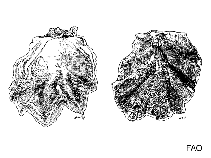Magallana sikamea (Amemiya, 1928)
Kumamoto oysterGoogle image | No image available for this species;
drawing shows typical species in Ostreidae.
Classification / Names Tên thường gặp | Các synonym ( Các tên trùng) | CoL | ITIS | WoRMS
Bivalvia | Ostreida | Ostreidae
Environment: milieu / climate zone / Mức độ sâu / distribution range Sinh thái học
; Thuộc về nước lợ. Subtropical; 37°N - 17°N, 108°E - 134°E
Distribution Các nước | Các khu vực của FAO | Các hệ sinh thái | Những lần xuất hiện | Những chỉ dẫn
Northwest Pacific: from Japan to South Korea, China and Taiwan.
Length at first maturity / Bộ gần gũi / Weight / Age
Chín muồi sinh dục: Lm ? range ? - ? cm Max length : 6.0 cm SHL con đực/không giới tính; (Tài liệu tham khảo 101471)
Life cycle and mating behavior Chín muồi sinh dục | Sự tái sinh sản | Đẻ trứng | Eggs | Sự sinh sản | Larvae
Main reference
Các tài liệu tham khảo | Người điều phối | Người cộng tác
Camara, M. D., J.P. Davis, M. Sekino, D. Hedgecock, G. Li, C.J. Langdon and S. Evans 2008 The Kumamoto oyster Crassostrea sikamea is neither rare nor threatened by hybridization in the Northern Ariake sea, Japan. Journal of Shellfish Research 27(2):313-322. (Tài liệu tham khảo 86665)
IUCN Red List Status
(Tài liệu tham khảo 130435: Version 2025-1)
CITES status (Tài liệu tham khảo 108899)
CMS (Tài liệu tham khảo 116361)
Threat to humans
Human uses
Các nghề cá: Tính thương mại
| FishSource | Biển chung quanh ta
Các công cụ
Thêm thông tin
Max. ages / sizes
Length-weight rel.
Length-length rel.
Length-frequencies
Mass conversion
Sự phong phú
Các nguồn internet
BHL | BOLD Systems | CISTI | DiscoverLife | FAO(Publication : search) | Fishipedia | GenBank (genome, nucleotide) | GloBI | Gomexsi | Google Books | Google Scholar | Google | PubMed | Cây Đời sống | Wikipedia (Go, tìm) | Tạp chí Zoological Record



